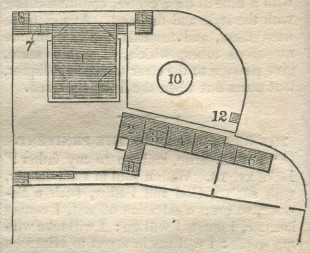…where east meets west
- Home
- Brief History
- The Greenwich Meridian
- Greenwich
(1675–1958) - Herstmonceux
(1948–1990) - Cambridge
(1990–1998) - Outstations (1822–1971)…
- – Chingford (1822–1924)
- – Deal
(1864–1927) - – Abinger
(1923–1957) - – Bristol & Bradford on Avon
(1939–1948) - – Bath
(1939–1949) - – Hartland
(1955–1967) - – Cape of Good Hope
(1959–1971)
- Administration…
- – Funding
- – Governance
- – Inventories
- – Pay
- – Regulations
- – Royal Warrants
- Contemporary Accounts
- People
- Publications
- Science
- Technology
- Telescopes
- Chronometers
- Clocks & Time
- Board of Longitude
- Libraries & Archives
- Visit
- Search
The Porter’s Lodge/Gate House

Plan of the Observatory in 1835. The accompanying key states: 12. Porter's lodge and gate. From The Weekly Visitor (Number CXVIII, Tuesday 17 February 1835, p.64)
No such building is shown on the site plans for 1831, 1835 or the later 1830s that are held in the official archives (RGO6/45), nor seemingly in a drawing by the reliable Elizabeth Smith dated 1 February 1839 (RGO116). But one does appear on the highly detailed site plan of 1846 (ADM140/426) and also on a crude plan published in the popular magazine The Weekly Visitor in its 17 February 1835 edition while John Pond was still Astronomer Royal. Click here to view the Plan with the complete key as published.
In its earliest known form, it consisted of a rudimentary wooden hut (referred to sometimes by Airy as a cabin) containing a heating stove. It was located behind the boundary wall to the right (north) of the double gates as you entered the courtyard. A plan by Airy dated 1853 (MFQ1/218) shows that at that time, the Porters also had a small room at the base of the supporting column for the East Equatorial (Sheepshank’s Equatorial) in what is now the north-west corner of the Observatory shop in the Meridian Building. This room, carved out of a larger space, is shown (but unannotated) on the plan published in the 1862 volume of Greenwich Observations and appears to have been created in 1849 (Board of Visitors report 1851). Given its proximity to the courtyard gates, it seems not unreasonable to suppose that the Porter’s may have used this area of the building from the time it was first erected in 1813.
In 1888/9, the Admiralty sanctioned the building of a new Porter’s Lodge or Gate House. After some delay, building work commenced on Monday 8 June 1890 and was completed by that autumn (RGO7/29/108). The new building was located close to where the old hut had stood, and on its northern side. Built of brick and of one storey, it had a tall chimney and oriel windows to the west and east, the east one projecting over the public path outside. The building was damaged when the gates received a direct hit during the Second World War on the night of 15 October 1940. Following temporary patching, the Gate House was properly repaired, the repairs being completed in 1946/7.
In 1954, as the working Observatory was in the throws of moving to Herstmonceux, the Ministry of Works drew up proposals for the future use of the buildings and grounds at Greenwich. They show that at that time, the plan was to demolish the Gate House and realign the boundary on which it stood. During a ministerial visit from the Ministry of Works on 22 April 1958, Hugh Molson (the Minister) indicated that he wanted the Gate House retained. By early 1960, the plans for its future had changed again. Park Lane in central London was about to be widened. Sections of railings and gates from Hyde Park were about to become available, and the Ministry of Works was keen to use them at Greenwich. This caused a rethink of the boundary treatment. Because the new railings were different in style to those that already existed at the Observatory, it was thought that it would be beneficial from a visual point of view, to demolish the Gate House and erect a new wall on its foundations to carry the Gate Clock – the wall providing a break-point between the two set of railings. At this point, the Minister’s views regarding the Gate House were reconsidered, but by now he was an ex-minister and they were ignored. In March 1960 a firm decision was taken to demolish the Gate House. It was demolished shortly afterwards.
© 2014 – 2025 Graham Dolan
Except where indicated, all text and images are the copyright of Graham Dolan